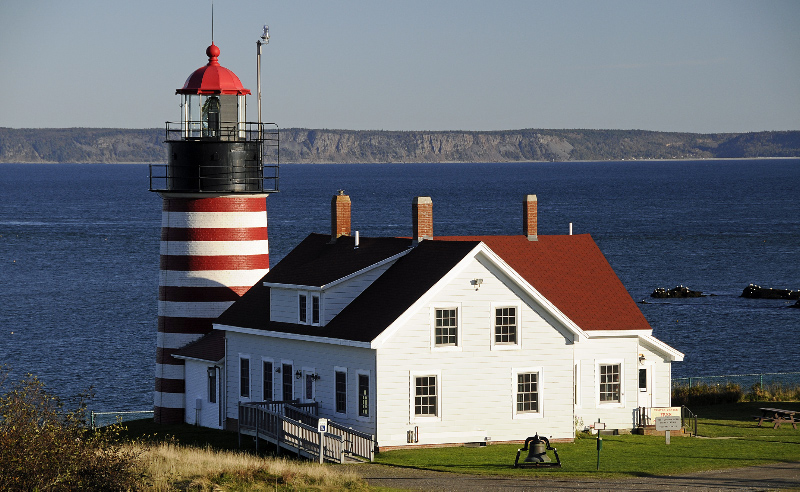
Quoddy Headlight marks the “easternmost point” in the U.S.
While vacationing in Maine, my husband and I ventured to Lubec, Maine, the gateway to Campobello Island, New Brunswick, Canada—the once popular summer colony for wealthy Americans and Canadians, including Franklin Delano Roosevelt. On our way we stopped at Quoddy Headlight, the easternmost point in the U.S. And once on Campobello, we went to the East Quoddy Lighthouse.
Perched on an island and only accessible in low tide, the East Quoddy Lighthouse called to our adventurous spirit. We were eager to make the trip across the sandbar and climb the steps to the lighthouse. Although it’s dangerous and rugged, for two hours when the tide is out visitors can climb the steep metal ladders, walk on the ocean floor, cross two intermediate islands connected by a short wooden bridge, take a second steep ladder and then walk across a rocky, slippery seaweed covered intertidal zone to get to the lighthouse. We were ready for the adventure when we were warned that the tide had turned. Then we saw the sign:
DANGER!-TAKE NO RISKS & DO NOT LINGER! If you become stranded on the islands by the tide, WAIT FOR RESCUE. Even former keepers of this lighthouse have lost their lives by misjudging the STRONG, FRIGID, FAST-RISING tidal currents and TIDE-PRESSURIZED UNSTABLE PEBBLE OCEAN FLOOR while attempting to make this crossing.
At that moment, Geoffrey Chaucer’s famous saying, “Time and tide wait for no man,” took on a whole new meaning for me.
The tides in this part of the Bay of Fundy are 25 feet or more. We learned that further up the bay in Nova Scotia, the tidal changes can be more than 50 feet and most extreme when the moon is full. These are the largest tidal changes in the world. That’s a lot of water moving in and out twice a day, and it was clear that the tides were the backdrop for the entire way of life in this part of Maine.
We saw firsthand the dramatic changes in the tides. In Lubec, there are poles on the wharf that go up nearly 20 feet, taking the dock with it as the water rises and falls. Like clockwork, an hour before high tide a dozen or more seals, cormorants, gulls, and bald eagles arrive to feed on the fish brought in by the tide. Travelling to these places and witnessing the significance of the tidal changes first hand brought Chaucer’s quote to life. The facts were important, but seeing the facts in action was exhilarating!
This experience made me realize the importance of “context” in describing any situation. Until I saw the physical power of these dramatic tides, the phrase “Time and tide wait for no man” had little meaning to me. But now I get it. You can’t beat the tides. The sea will never bow to your will. And no matter how strong a swimmer you are, at 50 degrees the water is too cold, the rips too unpredictable, and the force of the water flow too overpowering.
I often counsel my clients to use stories, metaphors, anecdotes, and quotes—the rhetorical devices that create compelling imagery and add power to your presentations. However, it is absolutely essential to also provide the context in which the images reside.
To create effective presentations we often use phrases from our own experience, thinking that our audience fully understands the meaning. But they may not understand where we’re coming from. So our challenge as communicators is not only to come up with and deliver the clever anecdote, quote, or quip, but also to be successful in communicating the broader world from which it evolves. Yes, the facts of tidal changes were compelling, but then there was the DANGER sign, the rising and falling poles on the dock in Lubec, and the sea life feeding at the exact same time every day. These images bore witness.
Therefore, I encourage you to find those fascinating rhetorical gems and take the time to fully render them in context. Tell us more; make it come alive.
And now, I’ve gotta run. The lighthouse beckons, and the tide is coming in!




